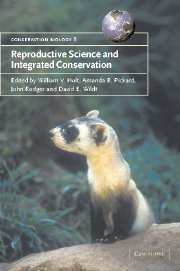Book contents
- Frontmatter
- Contents
- List of contributors
- Foreword
- Part I Introduction
- Part II Reproduction and population viability
- Part III Reproductive techniques for conservation management
- 9 Reproductive and welfare monitoring for the management of ex situ populations
- 10 Non-invasive endocrine measures of reproduction and stress in wild populations
- 11 Ultrasound for analysis of reproductive function in wildlife species
- 12 Role of embryo technologies in genetic management and conservation of wildlife
- 13 Application of nuclear transfer technology to wildlife species
- Part IV Integrated conservation management
- Part V Reproduction science in non-mammalian species
- Part VI Conclusions
- Index
- References
12 - Role of embryo technologies in genetic management and conservation of wildlife
Published online by Cambridge University Press: 21 January 2010
- Frontmatter
- Contents
- List of contributors
- Foreword
- Part I Introduction
- Part II Reproduction and population viability
- Part III Reproductive techniques for conservation management
- 9 Reproductive and welfare monitoring for the management of ex situ populations
- 10 Non-invasive endocrine measures of reproduction and stress in wild populations
- 11 Ultrasound for analysis of reproductive function in wildlife species
- 12 Role of embryo technologies in genetic management and conservation of wildlife
- 13 Application of nuclear transfer technology to wildlife species
- Part IV Integrated conservation management
- Part V Reproduction science in non-mammalian species
- Part VI Conclusions
- Index
- References
Summary
INTRODUCTION AND OBJECTIVES
This review critically evaluates the relative merits of reproductive techniques relating to embryo production and transfer for the genetic management and conservation of rare wildlife species.
The first live calf born following transfer of embryos between two domestic cows was produced by Willett and colleagues 50 years ago (Betteridge, 2000). Since that time, embryo transfer as an assisted reproductive technology (ART) has contributed enormously to the genetic improvement of livestock. In 1999, over half a million in vivo-derived, domestic bovine embryos were collected and transferred world-wide; more than half of these embryos were frozen-thawed, and at least another 26 000 bovine embryos were produced in vitro and transferred (Thibier, 2000). Embryo technologies have also had a significant impact on human reproduction, especially in treating infertility. In 1997 alone (the most recent data available), 335 fertility clinics in the United States reported the births of more than 24 500 babies (CDC, SART/ASRM and RESOLVE National Report, 1999). In Denmark, more than 4% of all human newborns are conceived by ART methods, including in vitro fertilisation (IVF) and sperm microinjection (Skakkebaek et al., 2000).
Certainly, the greatest progress in the development of embryo technologies has occurred in those few species where reproductive biology databases exist (e.g. cattle and primates). In most cases, methods have been developed in the species under study; in some cases, a common ‘model’ species is studied first before the technology is applied to a wild counterpart (Wildt et al., 1986; Loskutoff & Betteridge, 1992).
- Type
- Chapter
- Information
- Reproductive Science and Integrated Conservation , pp. 183 - 194Publisher: Cambridge University PressPrint publication year: 2002
References
- 1
- Cited by

